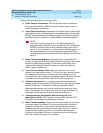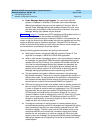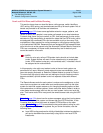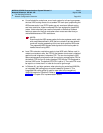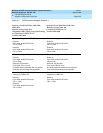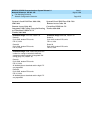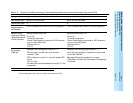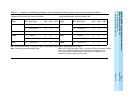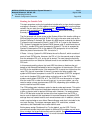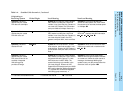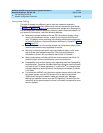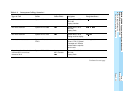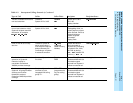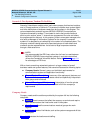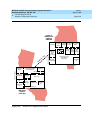
MERLIN LEGEND Communications System Release 6.1
Network Reference
555-661-150
Issue 1
August 1998
Call-Handling Scenarios
Page 2-26Network Configuration Scenarios
2
Routing for Outside Calls 2
This topic examines routing for hypothetical outside calls, to show how the system
managers in Scenario 1 work together to maximize cost benefits from the private
network. As you study the call route examples in Table 2–4, page 2-27
, review the
general setup as described in Table 2–2, page 2-24
and the ARS routing
summary in Table 2–3, page 2-25
.
The first example call shows a user at the System A New York location dialing an
ARS call beginning with the digits
, for a call in the same area code as the
System B location in Holmdel, NJ. System A’s ARS feature, invoked by the dialed
, allows the call, because the Route 1 (and 2) FRL is 0, equal to the extension
FRL. System A prepends the System B ARS access code, 9, and directs the call
to Route 1, tandem PRI trunks connected to System B. The call is accepted by
System B, because the FRL for the default COR assigned to all non-tie trunks
takes the place of an extension FRL. Its value is 3.
If Route 1 is busy, System A’s ARS directs the call to Route 2, which consists of
pools of local PSTN trunks. However, the FRL of 1 for the second route is higher
than the extension FRL of 0, so the call is denied. The user hears the fast busy
tone and could turn on Selective Callback to wait for an available Route 1 tandem
PRI trunk.
In this example and the others, the local ARS first allows or disallows the call
based on the Allowed/Disallowed list and a comparison of the extension FRL and
the FRL for the available route. If the extension FRL is equal to or higher than the
route FRL, the call is permitted. If the call is routed to the other system, that
system’s ARS feature compares its route FRL to the default COR FRL assigned
to all non-tie (tandem PRI) trunks before routing the call to the PSTN. Both
systems use a default COR FRL of 3. The COR FRL must be equal to or higher
than the route FRL in order for the call to go out. In your own system, you may
need to assign a lower remote access COR FRL, depending upon whether you
want to reserve local ARS routes.
The COR settings also include an option for barrier code requirement. This option
is ignored for ARS-routed and intersystem extension calls that arrive on tandem
trunks; no barrier code is required for these calls. However, if a remote access
DID or PRI dial-plan routed call arrives at the local system from the PSTN, a
barrier code
is
required; this requirement is important because the default COR
settings does not outward restrict such remote access calls. In addition, a barrier
code is required when a user dials a Remote Access code that is included in the
non-local dial plan. The system managers apply FRL restrictions, outward
restrictions, and Disallowed Lists to each barrier code.
Both systems assign Disallowed List 7 to the default, non-tie COR. This list
prevents calls across the private network to 900 and 976 numbers, as well as to
other numbers that organizations often want to prohibit. See “Facility Restriction
Levels and Remote Access” on page 5 for more information.



